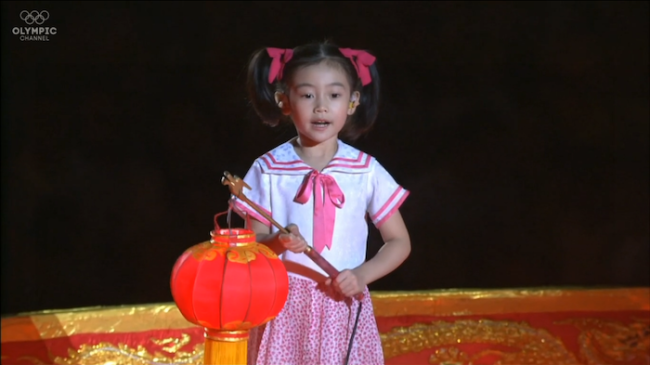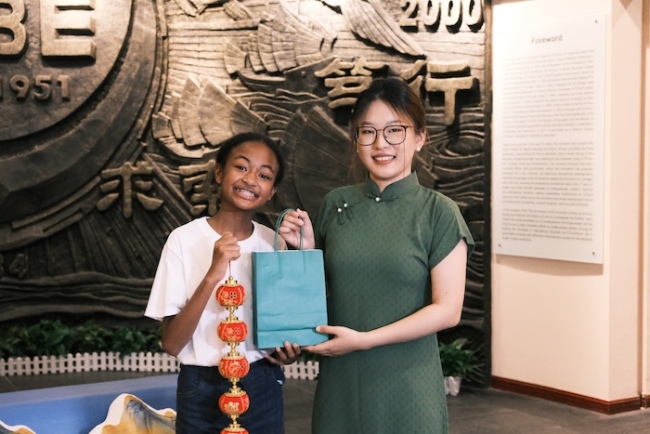日期:2025-11-06 05:19:50
编者按:在人类文明的演进过程中,音乐以其独特的艺术魅力,为不同文化的对话交流创造了更多可能性。一朵茉莉的芬芳,可以穿越数百年的时光,从江南水乡飘向世界舞台;一首民歌的旋律,能够跨越万水千山大旗策略,在不同的文化间激起回响。那些飘扬的音符告诉我们:文明互鉴的真谛,在于以开放包容的姿态,让多元文化在音乐的共鸣中听见彼此的心声。
在中国宋庆龄基金会“文化小大使”的活动现场坐满了来自世界各地因为喜爱中国文化而聚集在一起的青少年。当舞台从热闹变得安静,一段音乐悠扬奏起,在场观众仿佛沉浸在来自东方的神秘花朵的幽香中。“好一朵美丽的茉莉花,好一朵美丽的茉莉花……”这个来自马达加斯加的女孩,用清澈的嗓音唱响了她对中华文化的热爱。

图为涂妮接受采访现场
在中华网《青衿问道,文脉传承》栏目组的采访中,我们与这位马达加斯加女孩进行了一次深度访谈,探讨她热爱中华文化的缘由。“我叫涂妮,今年13岁,现在居住在塔那那利佛。”涂妮(Remamy Larenah Tony)笑着说。这是她第二次来到中国,“上次我去了北京和天津,那里的城市风光令我印象深刻。”虽然学习中文只有两年,但涂妮已经是“汉语桥”马达加斯加赛区小学组冠军。谈及学习中文的初衷,涂妮说:“是妈妈鼓励我学习中文的。虽然她是马达加斯加人,但是她很热爱中国文化。”备赛期间,母女俩常常一起学习中文。在学习方法上,她们选择了最自然,也是最快乐的途径——唱歌。涂妮学会的第一首中文歌,就是《茉莉花》。

图为涂妮与妈妈的合照
“怎么会想到用音乐来学习中国文化?”我们问道。涂妮想了想说:“因为,我本来很喜欢唱歌和弹钢琴,所以我通过学习中国歌曲来学中文,效率更高。”聊到唱歌,小女孩眼睛里闪烁着喜爱之情。在采访现场,她用清澈动人的嗓音再一次哼唱起这首闻名中外的经典民歌。
《茉莉花》起源于江浙一带,早在乾隆年间,戏曲剧本集《缀白球》便已收录其唱词:“好一朵茉莉花,好一朵茉莉花,满园的花开赛不过它,本待要,采一朵戴,又恐怕看花的骂。”这首歌旋律优美动听,朗朗上口,因此广为流传。历经两百多年的演变,《茉莉花》在全国范围内逐渐形成多个各具特色的地方版本,并最终成为具有代表性的中华艺术作品。
 大旗策略
大旗策略
图为雅典奥运会“北京八分钟”中小表演者演唱《茉莉花》
正是由于这首歌在中国地区的广泛流传,在明清时期,《茉莉花》的曲调就随商人和学者东渡日本、西传欧洲。1768年,启蒙思想家卢梭(Jean-Jacques Rousseau)将其收录于《音乐词典》,这也是《茉莉花》出现在西方最早的记载。25年后,英国学者约翰·巴罗(John Barrow)在广州的海幢寺用五线谱记录了已被和尚们改编成梵呗的《茉莉花》。贾科莫·普契尼(Giacomo Puccini)则从旧唱片中捕捉到《茉莉花》的旋律,将它写入《图兰朵》中高贵美丽的公主的咏叹,让茉莉的幽香永远萦绕在歌剧院的殿堂中。在遥远的欧洲文明中,这首来自中国的民族旋律被世界各地的人世代相传,在跨文化传播中展现出生生不息的活力。
从民间传唱的《鲜花调》到音乐家何仿据此改编的《茉莉花》,从爵士乐的即兴变奏到交响乐的恢宏演绎,《茉莉花》在一次次重塑中焕发新生,又始终保持着那份源自东方的音乐本真。在创造新的文化记忆的过程中,《茉莉花》不断地与其他文明对话,让东方的音乐智慧与世界各地的艺术灵魂相遇相融。

图为英国皇家爱乐合唱团与英国皇家合唱协会演唱《茉莉花》现场
在采访现场,我们好奇地问涂妮为什么会选择唱《茉莉花》。涂妮俏皮地眨了眨眼,说:“马达加斯加有一种独特的茉莉(Stephanotis floribunda),所以这首歌对我来说有一种亲切感。”音乐传递着文化的讯息,以一种独特的方式将我们连接。“茉莉”带来的巧合让原本陌生的心灵找到了共鸣,也让不同文化背景的人在旋律中感受到彼此的情感与温度。这样的交流不仅是艺术的碰撞,更是心灵与心灵跨越语言与地理障碍的对话。艺术在文化的土壤中滋养生长,也发挥着文化传承与文明交流的纽带作用。


图为马达加斯加茉莉图为中国常见的茉莉花
在流媒体时代大旗策略,除了那些经久不衰的传统歌曲,许多当代音乐作品也发挥着重要的文化传播作用。采访现场,涂妮演唱了最近的流行歌曲《上春山》。当“二月天杨柳醉春烟”的歌声响起,这首描绘贵州春色的民歌被赋予了新的文化意蕴。在“我上春山,约你来见”的文化邀约下,涂妮化身“文化小大使”来到中国,体验“山上儿童放纸鸢”的欢乐,感受“踏遍春山不思还”的文化眷恋。而那句“因为遇见你而不平凡”的告白,恰如其分地道出了她与中国相遇的珍贵与美好。

图为涂妮在采访现场与采编人员的合照
花朵不会移动,但香气随风远行;文化各有根系,却在歌声中枝叶相触。当清风拂过春山,当茉莉花香飘四海,音乐化作文化使者,以温和而有力的方式拉近了不同文明间的距离。作为人类共通的语言,音乐的伟大之处在于它既能守护文化的独特性,又能在旋律与节奏的流动中搭建理解的桥梁。
《茉莉花》等中国歌曲在全球范围内的传播历程告诉我们:真正具有生命力的文化符号,既要有坚守本真的定力,也要有拥抱变化的勇气。而青年一代的跨文化交流也不必总依靠宏大的项目或庄严的场合——一首歌,就足以成为出发的船票。

图为涂妮在中国印象·沙龙活动现场
全球化的时代背景下,我们需要更多像涂妮这样的“文化小大使”,用真诚的歌声搭建起文化交流的桥梁。当越来越多的年轻人愿意唱响彼此的民谣,当不同国家的孩子能在旋律中找到共鸣,人类文明的百花园必将更加绚丽多彩。
撰稿人:何博媛
责任编辑:刘雨婷
Melody as a Bridge: A Dialogue Among Civilizations
Editor's Note: Throughout the evolution of human civilization, music, with its unique artistic charm, has created more possibilities for dialogue and exchange among different cultures. The fragrance of a single jasmine flower can travel through centuries, from the water towns of Jiangnan to the world stage. The melody of a folk song can cross mountains and rivers, resonating between different cultures. The flowing notes tell us that the true meaning of mutual learning among civilizations lies in an open and inclusive attitude, allowing diverse cultures to hear each other's voices through the resonance of music.
At the recent Junior Cultural Ambassadors event hosted by the China Soong Ching Ling Foundation, teenagers from all over the world gathered, united by their love for Chinese culture. As the bustling stage grew quiet, a gentle melody began to play, and the audience seemed to be enveloped in the subtle fragrance of a mysterious flower from the East. "What a beautiful jasmine flower, what a beautiful jasmine flower..." The young girl from Madagascar sang with a crystal-clear voice, expressing her deep affection for Chinese culture.
In the interview with Inquiring Youth, Inheriting Culture(青衿问道,文脉传承) column, we had an in-depth conversation with the Malagasy girl, exploring the reasons behind her passion for Chinese culture. "My name is Tony, I'm 13 years old, and I live in Antananarivo," Remamy Larenah Tony said with a smile. This was her second visit to China. "Last time, I went to Beijing and Tianjin, and the cityscapes there left a deep impression on me." Although she has only been studying Chinese for two years, Tony is already the champion of the "Chinese Bridge" competition for primary school students in Madagascar. When asked about her initial motivation for learning Chinese, Tony said, "My mom encouraged me to learn Chinese. Even though she's Malagasy, she loves Chinese culture very much." During the competition preparation, the mother and daughter often studied Chinese together, choosing the most natural and enjoyable method: singing. The first Chinese song Tony learned was Jasmine Flower.
"What made you think of using music to learn about Chinese culture?" we asked. Tony thought for a moment and replied, "I really love singing and playing the piano, so I find it more efficient to learn Chinese by studying Chinese songs." As she talked about singing, her eyes sparkled with joy. During the interview, she once again hummed the classic folk song, which is famous both in China and abroad, with her beautiful, clear voice.
Jasmine Flower originated in the Jiangsu and Zhejiang regions. As early as the Qianlong era, a collection of opera scripts, Zhui Bai Qiu(《缀白球》), already included its lyrics: "What a beautiful jasmine flower, what a beautiful jasmine flower, no other flowers in the garden can surpass it. I was about to pick one to wear, but I was afraid of being scolded by the one who guards the flowers." The song's beautiful and catchy melody made it widely popular. Over more than two hundred years of evolution, Jasmine Flower gradually developed many unique regional versions across the country and eventually became a representative work of Chinese art.
Due to the song's wide popularity in China, its melody traveled east to Japan and west to Europe with merchants and scholars during the Ming and Qing dynasties. In 1768, the Enlightenment philosopher Jean-Jacques Rousseau included it in his Dictionary of Music, which is the earliest record of the song appearing in the West. Twenty-five years later, British scholar John Barrow transcribed a version of Jasmine Flower that monks at the Hualin Temple(《海幢寺》) in Guangzhou had adapted into a Buddhist chant, recording it in a musical score for his travelogue, Travels in China. Giacomo Puccini captured the melody from old records and incorporated it into the aria of the noble and beautiful princess in his opera, Turandot, allowing the subtle fragrance of jasmine to forever linger in the opera house. In the distant context of European civilization, this Chinese melody has been passed down through generations, showcasing its endless vitality in cross-cultural exchange.
From the folk song Fresh Flower Melody to the adapted Jasmine Flower by musician He Fang, and from impromptu jazz variations to magnificent symphonic interpretations, the song has been reborn through repeated reinvention while always maintaining its Eastern musical essence. In the process of creating new cultural memories, Jasmine Flower continuously dialogues with other civilizations, allowing Eastern musical wisdom to meet and blend with artistic souls from around the world.
During the interview, we were curious to ask Tony why she chose to sing Jasmine Flower. With a playful wink, Tony said, "There is a unique type of jasmine in Madagascar (Stephanotis floribunda), so this song feels familiar to me." Music conveys cultural messages, connecting us in a unique way. The coincidence of "jasmine" allows otherwise unfamiliar hearts to find resonance and enables people from different cultural backgrounds to feel each other's emotions and warmth through melody. This kind of exchange is not just an artistic collision; it is a dialogue between hearts that transcends the barriers of language and geography. Art grows and thrives in the soil of culture, and it also serves as a bridge for cultural heritage and exchange among civilizations.
In the streaming era, many contemporary musical works, in addition to timeless traditional songs, also play an important role in cultural dissemination. During the interview, Tony sang the recent popular song, "Shang Chun Shan" (《上春山》). As the lyrics "The willow is intoxicated in the spring mist on a February day" were sung, this folk song, which describes the spring scenery of Guizhou, was imbued with new cultural significance. Under the invitation of the lyrics "I'm climbing the spring mountain, inviting you to meet me," Tony, as a "Junior Cultural Ambassador," came to China to experience the joy of "children flying kites on the mountain" and feel the cultural attachment of "wandering through the spring mountains, with no thought of returning." And the confession "Because of meeting you, I am not ordinary" perfectly expresses the precious and beautiful nature of her encounter with China.
Flowers do not move, but their fragrance travels with the wind. Cultures have their own roots, but they touch branches and leaves in song. When the gentle breeze sweeps across the spring mountains and the fragrance of jasmine drifts across the four seas, music becomes a cultural envoy, bridging the distance between different civilizations in a gentle yet powerful way. As a universal human language, the greatness of music lies in its ability to both preserve the uniqueness of cultures and build bridges of understanding through the flow of melody and rhythm.
The global spread of Chinese songs like Jasmine Flower tells us that truly vibrant cultural symbols must have both the resolve to adhere to their essence and the courage to embrace change. And for the younger generation, cross-cultural exchange doesn't always have to rely on grand projects or solemn occasions—a single song can be a ticket for a journey.
In the context of globalization大旗策略, we need more Junior Cultural Ambassadors like Tony, who use their heartfelt songs to build bridges for cultural exchange. When more young people are willing to sing each other's folk songs,and children from different countries can find common ground in melody, the magnificent garden of human civilization is bound to become more colorful and vibrant.
秦安配资提示:文章来自网络,不代表本站观点。
- 上一篇:泸深在线 文班34+14+6帽马刺险胜! 轰40+2, 给新秀让路? 篮网把握不住机会
- 下一篇:没有了



